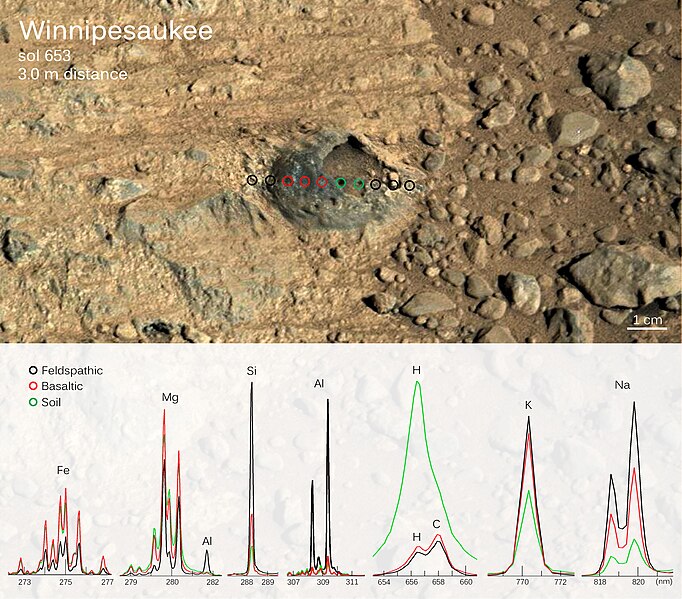File:PIA18396-MarsCuriosityRover-WinnipesaukeeRock-20140625.jpg

Original file (3,235 × 2,842 pixels, file size: 1.59 MB, MIME type: image/jpeg)
Captions
Captions
Summary edit
| DescriptionPIA18396-MarsCuriosityRover-WinnipesaukeeRock-20140625.jpg |
English: 06.25.2014
Martian Rock and Dust Filling Studied with Laser and Camera http://mars.jpl.nasa.gov/msl/multimedia/images/?ImageID=6428 Scientists used the Chemistry and Camera (ChemCam) instrument on NASA's Curiosity Mars rover in June 2014 to examine a Martian rock "shell" about one inch (two to three centimeters) across, embedded in fine-grained bedrock and with a dust-filled hollow interior. This graphic combines an image of the target, called "Winnipesaukee," with spectrographic results from using ChemCam's laser on a row of points including the rock, the matrix around it and the material filling it. The image merges a high-resolution, black-and-white image from ChemCam's remote micro-imager and a color image form the telephoto-lens camera of Curiosity's Mast Camera (Mastcam). The ChemCam laser and camera atop of Curiosity's remote sensing mast were about 9 feet, 10 inches (3 meter) from Winnipesaukee when the instrument examined Winnipesaukee on the 654th Martian day, or sol, of the rover's work on Mars (June 8, 2014). Similar-appearing features have been seen previously in the mission, but this time ChemCam was able to provide chemical analysis of the structure. The instrument fired 30 laser shots at each of 10 locations indicated by black, red and green circles on the image. Three distinct types of materials were analyzed: the bedrock on each side of the structure, the "shell" material itself and the dust inside the void space. The colors of the lines on the graph below the image correspond to the colors of the circles marking the laser-shot locations. Analysis of spectra from the bedrock (black circles) identified high abundances of oxides of silicon, aluminum and sodium, typical of a feldspathic composition. The material forming the "shell" (red circles) has a more basaltic or mafic composition, with higher iron and magnesium content. The dust (green circles) is almost certainly airborne material that accumulated in the void space. This dust contains a relatively high hydrogen (water) signature compared to other Martian materials, which is generally characteristic of the ubiquitous dust that forms a thin mantle on much of the surface. Scientists are considering multiple hypotheses for how this hollow feature formed. Formation as a bubble or carapace of rock that was embedded in the surrounding sediment cannot be ruled out. One alternative considered more likely is that transport of fluids through the bedrock could produce pipe-like structures with a wall consisting of bedrock that either has reacted with the fluids or has been coated with other material. Another is that the feature formed due to cracks penetrating the bedrock, then a mineral cement filling the cracks, then wind erosion removing material from the center. ChemCam is one of 10 instruments in Curiosity's science payload. The U.S. Department of Energy's Los Alamos National Laboratory, Los Alamos, N.M., developed ChemCam in partnership with scientists and engineers funded by the French national space agency, CNES, the University of Toulouse and research agency, CNRS. More information about ChemCam is available at http://www.msl-chemcam.com . The rover's MastCam was built by and is operated by Malin Space Science Systems, San Diego. |
| Date | |
| Source | http://mars.jpl.nasa.gov/msl/images/PIA18396_ccam-mcam_winnipesaukee-full.jpg |
| Author | NASA/JPL-Caltech/LANL/CNES/IRAP/LPGNantes/CNRS/IAS/MSSS |
Licensing edit
| Public domainPublic domainfalsefalse |
| This file is in the public domain in the United States because it was solely created by NASA. NASA copyright policy states that "NASA material is not protected by copyright unless noted". (See Template:PD-USGov, NASA copyright policy page or JPL Image Use Policy.) |  | |
 |
Warnings:
|
File history
Click on a date/time to view the file as it appeared at that time.
| Date/Time | Thumbnail | Dimensions | User | Comment | |
|---|---|---|---|---|---|
| current | 15:39, 13 July 2014 |  | 3,235 × 2,842 (1.59 MB) | Drbogdan (talk | contribs) | User created page with UploadWizard |
You cannot overwrite this file.
File usage on Commons
The following page uses this file:
- File:Pia18396 Curiosity ccam-mcam winnipesaukee.jpg (file redirect)
File usage on other wikis
The following other wikis use this file:
- Usage on en.wikipedia.org
- Usage on ja.wikipedia.org
- Usage on pl.wikipedia.org
- Usage on zh.wikipedia.org
Metadata
This file contains additional information such as Exif metadata which may have been added by the digital camera, scanner, or software program used to create or digitize it. If the file has been modified from its original state, some details such as the timestamp may not fully reflect those of the original file. The timestamp is only as accurate as the clock in the camera, and it may be completely wrong.
| Width | 1,344 px |
|---|---|
| Height | 1,200 px |
| Bits per component |
|
| Pixel composition | RGB |
| Orientation | Normal |
| Number of components | 3 |
| Horizontal resolution | 72 dpi |
| Vertical resolution | 72 dpi |
| Software used | Adobe Photoshop CS6 (Windows) |
| File change date and time | 16:19, 17 June 2014 |
| Exif version | 2.21 |
| Color space | Uncalibrated |
| Unique ID of original document | FC969D7194125231EE05830F6E1FDCFF |
| Date and time of digitizing | 20:02, 11 June 2014 |
| Date metadata was last modified | 18:19, 17 June 2014 |
| IIM version | 64,402 |